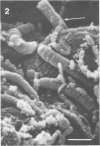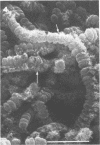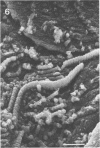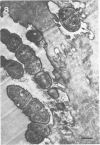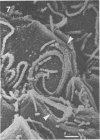Abstract
Tongue samples from cattle on varied diets and ranging in age from 2 months to adult were studied by transmission and scanning electron microscopy to observe the in situ distribution and adhesion patterns of two readily identifiable genera of filamentous bacterial. The two, both members of the Simonsiellaceae, adhere to the epithelium by means of fibers which are produced on one side of the bacterial filaments and subsequently display a sidedness in their manner of adhesion to epithelial surfaces. Other bacterial populations found on the tongue were normally members of chains and seldom present as single cells. This suggests that filamentous or chain-forming bacteria may have a selective advantage over single bacteria in their ability to colonize and remain attached to the epithelium of the tongue.
Full text
PDF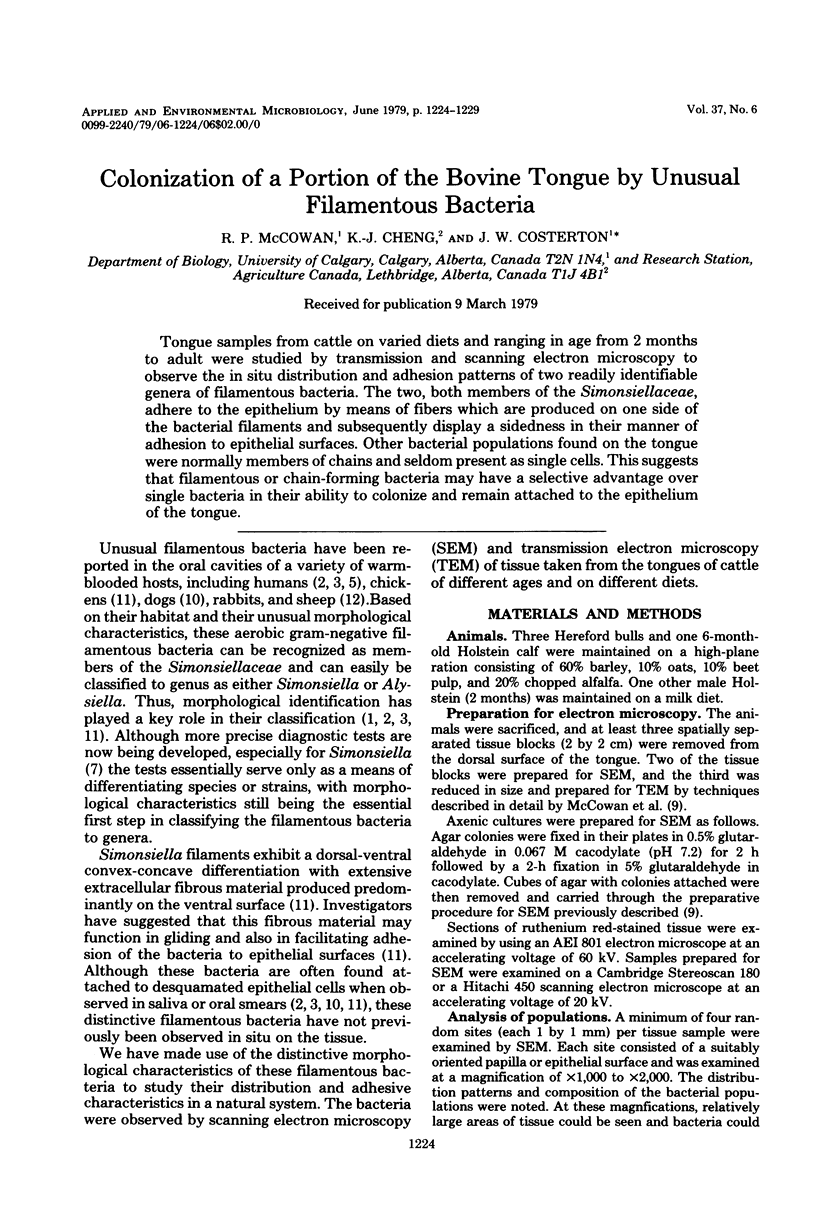



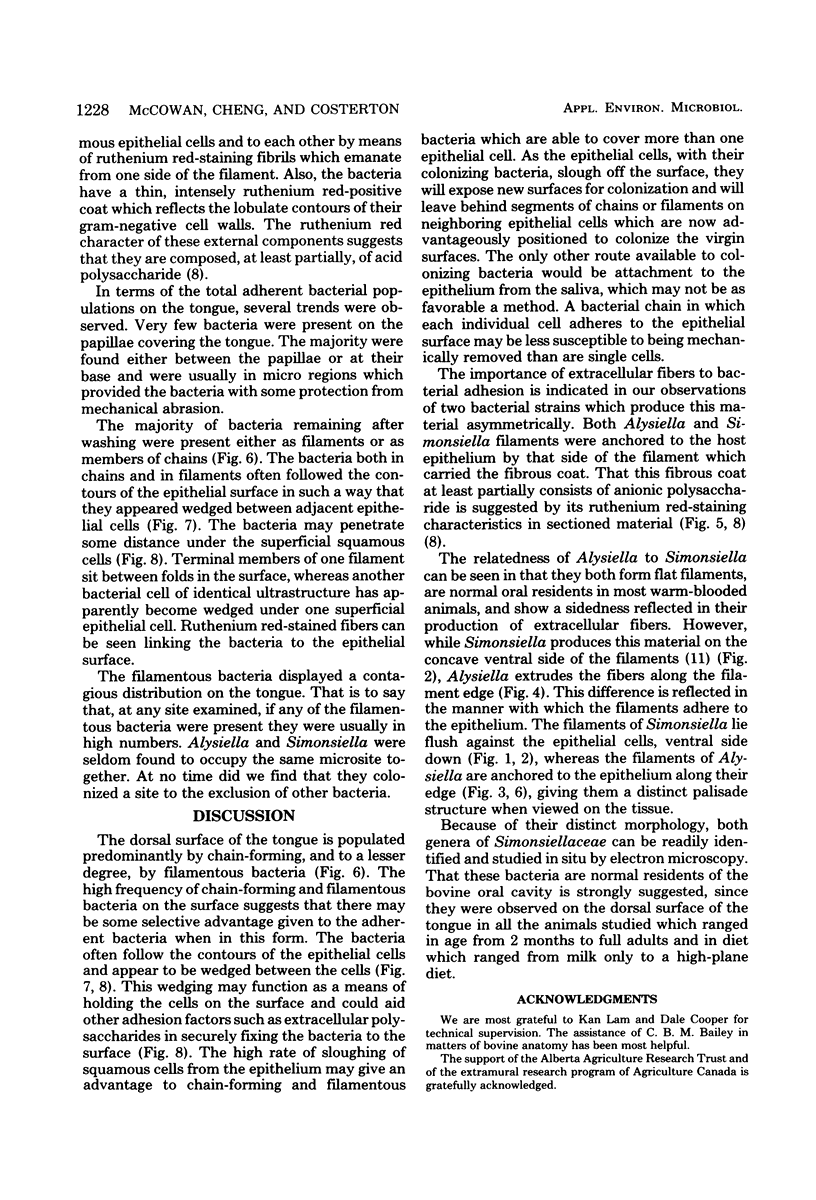

Images in this article
Selected References
These references are in PubMed. This may not be the complete list of references from this article.
- Bailie W. E., Stowe E. C., Schmitt A. M. Aerobic bacterial flora of oral and nasal fluids of canines with reference to bacteria associated with bites. J Clin Microbiol. 1978 Feb;7(2):223–231. doi: 10.1128/jcm.7.2.223-231.1978. [DOI] [PMC free article] [PubMed] [Google Scholar]
- Bruckner R. J., Fahey S. H. A giant bacterial form (Simonsiella) seen in oral exfoliative cytology preparations. Oral Surg Oral Med Oral Pathol. 1969 Aug;28(2):197–201. doi: 10.1016/0030-4220(69)90287-4. [DOI] [PubMed] [Google Scholar]
- Gregory M. C., Hammond M. E., Brewer E. D. Renal deposition of cytomegalovirus antigen in immunoglobulin-A nephropathy. Lancet. 1988 Jan 2;1(8575-6):11–14. doi: 10.1016/s0140-6736(88)91000-8. [DOI] [PubMed] [Google Scholar]
- Jenkins C. L., Kuhn D. A., Daly K. R. Fatty acid composition of Simonsiella strains. Arch Microbiol. 1977 Jun 20;113(3):209–213. doi: 10.1007/BF00492027. [DOI] [PubMed] [Google Scholar]
- Kuhn D. A., Gregory D. A., Nyby M. D., Mandel M. Deoxyribonucleic acid base composition of Simonsiellaceae. Arch Microbiol. 1977 Jun 20;113(3):205–207. doi: 10.1007/BF00492026. [DOI] [PubMed] [Google Scholar]
- Luft J. H. Ruthenium red and violet. I. Chemistry, purification, methods of use for electron microscopy and mechanism of action. Anat Rec. 1971 Nov;171(3):347–368. doi: 10.1002/ar.1091710302. [DOI] [PubMed] [Google Scholar]
- McCowan R. P., Cheng K. J., Bailey C. B., Costerton J. W. Adhesion of bacteria to epithelial cell surfaces within the reticulo-rumen of cattle. Appl Environ Microbiol. 1978 Jan;35(1):149–155. doi: 10.1128/aem.35.1.149-155.1978. [DOI] [PMC free article] [PubMed] [Google Scholar]
- Nyby M. D., Gregory D. A., Kuhn D. A., Pangborn J. Incidence of Simonsiella in the oral cavity of dogs. J Clin Microbiol. 1977 Jul;6(1):87–88. doi: 10.1128/jcm.6.1.87-88.1977. [DOI] [PMC free article] [PubMed] [Google Scholar]
- Pangborn J., Kuhn D. A., Woods J. R. Dorsal-ventral differentiation in Simonsiella and other aspects of its morphology and ultrastructure. Arch Microbiol. 1977 Jun 20;113(3):197–204. doi: 10.1007/BF00492025. [DOI] [PubMed] [Google Scholar]
- STEED P. A. Simonsiellaceae fam.nov.with characterization of Simonsiella crassa and Alysiella filiformis. J Gen Microbiol. 1962 Dec;29:615–624. doi: 10.1099/00221287-29-4-615. [DOI] [PubMed] [Google Scholar]



